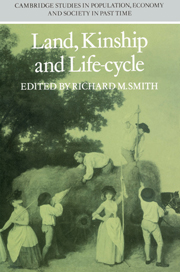Book contents
- Frontmatter
- Contents
- List of contributors
- Preface
- 1 Some issues concerning families and their property in rural England 1250–1800
- 2 Population pressure, inheritance and the land market in a fourteenth-century peasant community
- 3 Families and their land in an area of partible inheritance: Redgrave, Suffolk 1260–1320
- 4 Population changes and the transfer of customary land on a Cambridgeshire manor in the fourteenth century
- 5 Industrial employment and the rural land market 1380– 1520
- 6 Changes in the size of peasant holdings in some west midland villages 1400–1540
- 7 The erosion of the family–land bond in the late fourteenth and fifteenth centuries: a methodological note
- 8 Changes in the link between families and land in the west midlands in the fourteenth and fifteenth centuries
- 9 Kinship in an English village: Terling, Essex 1550–1700
- 10 The myth of the peasantry: family and economy in a northern parish
- 11 Poverty, poor relief and the life-cycle: some evidence from seventeenth-century Norfolk
- 12 The receipt of poor relief and family situation: Aldenham, Hertfordshire 1630–90
- 13 Widows in pre-industrial society: an essay upon their economic functions
- 14 Real property, marriage and children: the evidence from four pre-industrial communities
- 15 The nineteenth-century peasantry of Melbourn, Cambridgeshire
- Consolidated Bibliography
- Index
15 - The nineteenth-century peasantry of Melbourn, Cambridgeshire
Published online by Cambridge University Press: 19 October 2009
- Frontmatter
- Contents
- List of contributors
- Preface
- 1 Some issues concerning families and their property in rural England 1250–1800
- 2 Population pressure, inheritance and the land market in a fourteenth-century peasant community
- 3 Families and their land in an area of partible inheritance: Redgrave, Suffolk 1260–1320
- 4 Population changes and the transfer of customary land on a Cambridgeshire manor in the fourteenth century
- 5 Industrial employment and the rural land market 1380– 1520
- 6 Changes in the size of peasant holdings in some west midland villages 1400–1540
- 7 The erosion of the family–land bond in the late fourteenth and fifteenth centuries: a methodological note
- 8 Changes in the link between families and land in the west midlands in the fourteenth and fifteenth centuries
- 9 Kinship in an English village: Terling, Essex 1550–1700
- 10 The myth of the peasantry: family and economy in a northern parish
- 11 Poverty, poor relief and the life-cycle: some evidence from seventeenth-century Norfolk
- 12 The receipt of poor relief and family situation: Aldenham, Hertfordshire 1630–90
- 13 Widows in pre-industrial society: an essay upon their economic functions
- 14 Real property, marriage and children: the evidence from four pre-industrial communities
- 15 The nineteenth-century peasantry of Melbourn, Cambridgeshire
- Consolidated Bibliography
- Index
Summary
This essay attempts to answer the question as to the extent to which a peasantry survived in nineteenth-century Melbourn and the factors involved in its survival. The evidence used relates to the occupations of the families concerned, as well as to land, kinship and inheritance. Occupations are important because the definition of ‘peasantry’ used in this chapter embraces many kinds of rural entrepreneurs, who usually also had some kind of interest in the land. A peasant is regarded as any self-employed man below the rank of the large tenant farmers and the yeomen (i.e. the large owner-occupier farmers). Unlike the labourer, he did not rely entirely on wages and, unlike the higher groups, he did not rely mainly on directing the work of others. His living was obtained by virtue of a combination of a modest amount of capital with family labour and, in some instances, hired help. The typical Melbourn peasant was a dual-occupationist, and this also helped to distinguish him from the full-time farmers, whether they were tenants or yeomen, and from the very few professional men who lived in the village.
Melbourn in 1839–41
Melbourn is situated on the lower parts of the chalk plain about ten miles south of Cambridge where corn farming had been traditional for several centuries. By local standards it was both a large parish and a large village.
- Type
- Chapter
- Information
- Land, Kinship and Life-Cycle , pp. 481 - 518Publisher: Cambridge University PressPrint publication year: 1985

